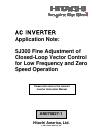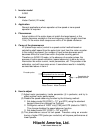
1. Inverter model
SJ300
2. Control
Vector Control (V2 mode)
3. Application
General applications where operation at low speed or zero speed
operation is required.
4. Phenomenon
Actual rotation of the motor does not match the target speed, or the
rotation becomes unstable in the low frequency range (roughly less than
1 Hz). Or the motor shaft creeps even with a 0 Hz speed reference.
5. Cause of the phenomenon
V2 (closed-loop vector) control is a speed control method based on
calculating shaft speed from the pulse train input from the motor encoder.
In the case of low speed, the number of input pulses decrease and it
becomes difficult to count them within the pulse counting period.
Therefore on SJ300 V2 mode, in the absence of encoder pulses, the
process of motor speed estimation (speed observing) is done by using
information like motor current, motor parameters, etc. This process is an
estimation, and will have some errors. It sometimes results in instability
as described above in item 4.
Speed observer
Speed detection when there
are pulses from the encoder
Encoder pulse
Speed data for
speed control
Motor constants
Motor current
6. How to adjust
(1) Adjust motor parameters, inertia parameter (J) in particular, and try to
obtain optimal motor performance.
(2) Disable the speed-observing function by the following method:
c Set debug mode ON ([C091] = “01” and STR) using the standard
keypad (cannot be changed via ProDrive)
d Configure a value of “4000” into [C193] and STR (default is “0000”)
This change disables the speed observer function.
e Set debug mode OFF ([C091] = “00” and STR
(3) This phenomenon occurs at low speed. Therefore using an encoder
having a higher PPR (pulse per revolution) will improve performance at
lower speeds.
Hitachi America, Ltd.
© 2007 Hitachi America, Ltd.




